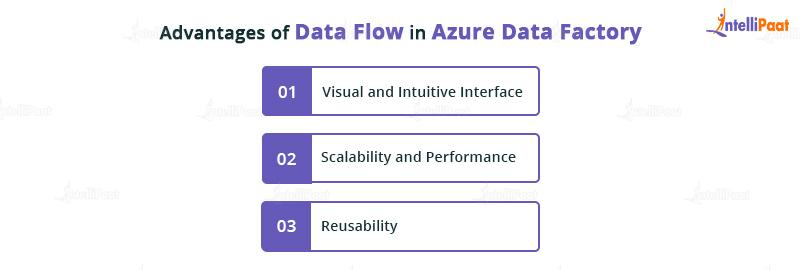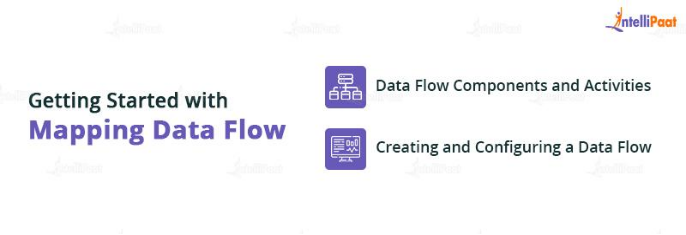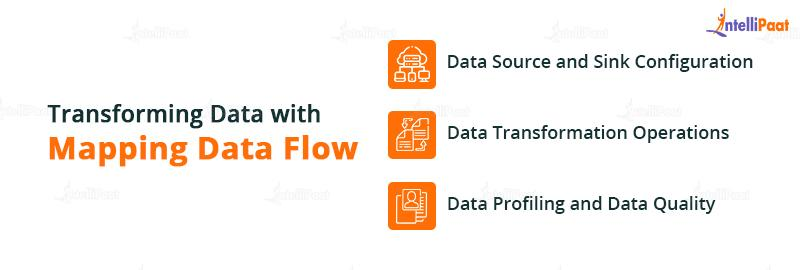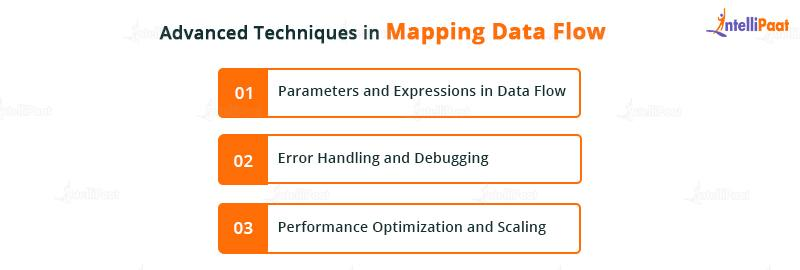What is Data Flow in Azure Data Factory? – Mapping Data Flow
This guide will help you understand the basics of Data Flow in Azure Data Factory, specifically focusing on Mapping Data Flow.
- Introduction to Data Flow in Azure Data Factory
- Advantages of Data Flow in Azure Data Factory
- Getting Started with Mapping Data Flow
- Transforming Data with Mapping Data Flow
- Advanced Techniques in Mapping Data Flow
- Monitoring and Managing Mapping Data Flow
- Real-World Use Cases for Mapping Data Flow
- Conclusion
Introduction to Data Flow in Azure Data Factory
Data Flow is an extremely useful feature of the Azure Data Factory. It offers a simple user interface that makes it possible to design data integration pipelines without the use of intricate coding. Data Flow allows users to extract, transform, and load (ETL) data from diverse sources to their intended destinations.
Advantages of Data Flow in Azure Data Factory

There are several advantages to using Data Flow in Azure Data Factory: Visual and Intuitive Interface: Data Flow provides a drag-and-drop interface that allows users to design data transformation workflows visually. This helps technical and non-technical users create and manage data integration pipelines.
- Scalability and Performance: Data Flow uses Azure’s distributed processing capacity to scale up or down depending on data volume and processing requirements. It allows parallel data processing, which results in faster execution times for huge datasets.
- Reusability: Users can utilize Data Flow to develop reusable components, such as transformations and mappings, that can be shared across numerous data integration pipelines. This enhances the data transformation process’s efficiency and consistency.
Looking to become a Certified Azure Administrator? Check out our Azure Course!
Getting Started with Mapping Data Flow

The essential component of Data Flow in Azure Data Factory is Mapping Data Flow. It gives users a visual canvas to specify data conversions and actions. To get started with Mapping Data Flow, users must first comprehend its components and actions before proceeding with the following steps:
- Data Flow Components and Activities: Mapping Data Flow consists of various components such as data sources, data sinks, transformations, and actions. Data sources define the input data, data sinks specify the output destinations, transformations perform data operations, and actions allow users to control the flow of data.
- Creating and Configuring a Data Flow: Users can create a Data Flow by defining the source and destination of datasets and dragging and dropping transformations onto the canvas. They can configure the properties of each component and define the data mapping and required transformations.
Transforming Data with Mapping Data Flow

Mapping Data Flow provides a range of capabilities for transforming data within the Azure Data Factory. Users can perform various data transformation operations to shape and enrich the data. Some of the key aspects of data transformation with Mapping Data Flow include:
- Data Source and Sink Configuration: Users can configure the source and sink datasets, define the schema, specify file formats, and set up connectivity to external data sources.
- Data Transformation Operations: Mapping Data Flow supports many transformation operations, including filtering, sorting, aggregating, joining, separating, pivoting, and unpivoting data. These operations can be performed visually, allowing users to perform data transformations without writing advanced code.
- Data Profiling and Data Quality: Mapping Data Flow provides built-in data profiling capabilities that enable users to analyze data and identify data quality issues. Users can perform data cleansing, validation, and enrichment operations to ensure data accuracy and consistency.
Advanced Techniques in Mapping Data Flow

Once users have mastered the fundamentals of Mapping Data Flow, they may explore additional ways to improve their data transformation processes. Some advanced methods include the following:
- Parameters and Expressions in Data Flow
Users can leverage parameters and expressions to make their Data Flow pipelines dynamic and flexible. Parameters allow users to pass values at runtime, while expressions enable users to perform calculations, apply conditional logic, and manipulate data within the Data Flow.
- Error Handling and Debugging
Mapping Data Flow provides capabilities for handling errors and debugging pipelines. Users can configure error-handling strategies, define error outputs, and track the execution of their Data Flow pipelines for troubleshooting and optimization.
- Performance Optimization and Scaling
Partitioning, caching, and parallel processing are among the approaches that users can utilize to improve the speed of their Data Flow pipelines. These strategies help increase data processing efficiency and decrease execution times, particularly for large-scale data transformations.
Go through these Azure Data Factory Interview Questions and Answers to excel in your interview.
Monitoring and Managing Mapping Data Flow
- Monitoring Data Flow Runs: Monitoring the execution of Mapping Data Flows is crucial to ensure the accuracy and reliability of data transformations. Azure Data Factory provides built-in monitoring capabilities that allow you to track the progress, and status of Data Flow runs.
You can monitor the data flow execution using the Azure portal, REST API, or PowerShell cmdlets. These monitoring tools provide detailed information about the input and output data, transformation steps, and any errors encountered during the execution.
For example, let’s consider a scenario where you have a Mapping Data Flow that performs data transformations on a daily basis. By monitoring the Data Flow runs you can easily identify any issues or bottlenecks in the data transformation process. You can track the number of rows processed, the execution time, and any failed records, allowing you to quickly troubleshoot and rectify any issues.
- Data Flow Triggers and Scheduling: In Azure Data Factory, you can schedule the execution of Mapping Data Flows using triggers. Triggers enable you to define when and how often the Data Flow should run. You can schedule Data Flow runs based on a specific time, recurrence pattern, or even based on the availability of new data in the source system.
For instance, let’s say you have a Mapping Data Flow that transforms data from an on-premises database to Azure Data Lake Storage. You can configure a trigger to execute the Data Flow every night at a specific time. This ensures that the transformed data is available for downstream analytics or reporting processes.
- Managing Data Flow Metadata and Dependencies: When mapping Data Flows in Azure Data Factory, dependencies on numerous data sources, datasets, and related services may exist. Metadata and dependencies must be managed and maintained to ensure Data Flows function properly.
You can quickly create and manage the dependencies between different components of the Data Flow by leveraging Azure Data Factory’s metadata-driven approach. This enables fast data lineage tracking and allows the system to automatically resolve dependencies during Data Flow execution.
Assume you have a Mapping Data Flow that needs information from several sources, such as a SQL database, a CSV file, and an API. By appropriately handling the metadata and dependencies, you ensure that the Data Flow can effortlessly access and integrate data from these various sources.
Real-World Use Cases for Mapping Data Flow
- ETL and Data Integration Scenarios:
Mapping Data Flow is commonly used in ETL (Extract, Transform, Load) and data integration scenarios. It allows you to extract data from various sources, apply transformations, and load the transformed data to a target destination. For instance, you can use Mapping Data Flow to extract customer data from an on-premises database, perform data cleansing and enrichment, and load the transformed data into Azure Data Lake Storage or a data warehouse.
- Data Warehouse and Data Mart Implementations:
Data warehouse and data mart solutions can be implemented using Mapping Data Flow. It lets you carry out intricate data transformations and aggregations to produce a condensed view of the data. You can quickly load data into your data warehouse or data mart with Mapping Data Flow, ensuring it adheres to the correct structure and format.
- Real-Time Data Processing:
Mapping Data Flow can also be used for real-time data processing scenarios. By leveraging real-time data sources, such as Azure Event Hubs or IoT Hubs, you can design Mapping Data Flows to process and transform streaming data in near real-time. This enables you to perform real-time analytics, generate actionable insights, and trigger immediate actions based on the transformed data.
Conclusion
A powerful tool for data integration and transformation is mapping Data Flow in Azure Data Factory. By monitoring and managing Data Flow runs you can ensure that your data transformation operations are accurate and effective. The ability to plan Data Flow runs and manage metadata and dependencies expands Mapping Data Flow’s capabilities.
With real-world use cases spanning ETL, data warehousing, and real-time data processing, Mapping Data Flow is a versatile solution for a wide range of data scenarios. Incorporating Mapping Data Flow into your data workflows can significantly streamline and optimize your data integration and transformation processes.
If you have any doubts, you can post them in our Community!
The post What is Data Flow in Azure Data Factory? – Mapping Data Flow appeared first on Intellipaat Blog.
Blog: Intellipaat - Blog
Leave a Comment
You must be logged in to post a comment.







